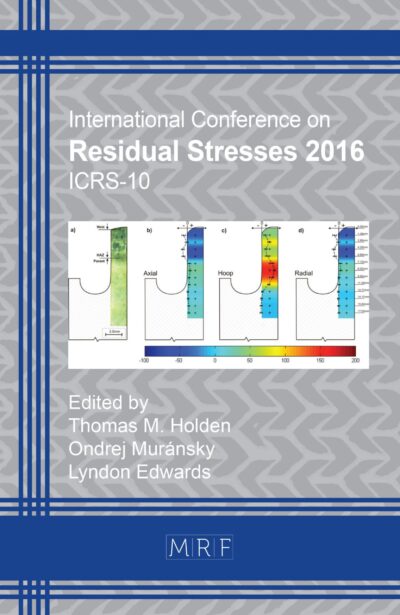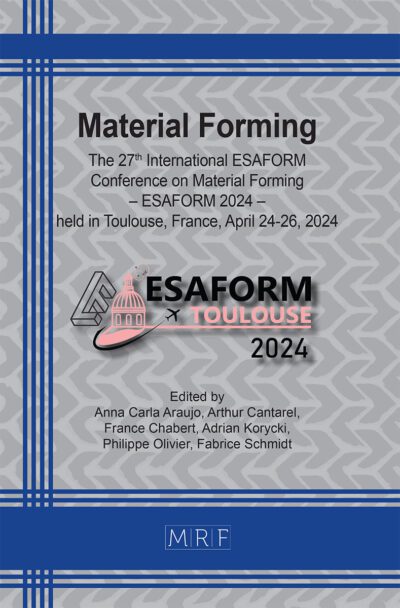Comparative analysis of a hypoelastic formulation with a hyperelastic one in the simulation of sheet metal forming processes
Marta C. OLIVEIRA, Rúben T. ALMEIDA, João P. BRITO, José L. ALVES
Abstract. Two formulations are explored in the context of elastoplasticity: (i) hypoelastic, based on plastic potentials in the stress space, and (ii) hyperelastic, based on plastic potentials in the strain space. The main objective is to compare these formulations regarding their computational efficiency in function of the increment of (pseudo)-time. The example considered is the forming of a square cup. The results showed that hyperelastic formulation offers greater computational efficiency, especially with the increase in the (pseudo)-time increment, without significantly compromising accuracy. The hypoelastic one presented convergence difficulties with larger increments of (pseudo)-time.
Keywords
Finite Element Method, Hypoelasticity, Hyperelasticity, Large Deformation Plasticity, Anisotropy, Computational Efficiency
Published online 5/7/2025, 10 pages
Copyright © 2025 by the author(s)
Published under license by Materials Research Forum LLC., Millersville PA, USA
Citation: Marta C. OLIVEIRA, Rúben T. ALMEIDA, João P. BRITO, José L. ALVES, Comparative analysis of a hypoelastic formulation with a hyperelastic one in the simulation of sheet metal forming processes, Materials Research Proceedings, Vol. 54, pp 1992-2001, 2025
DOI: https://doi.org/10.21741/9781644903599-214
The article was published as article 214 of the book Material Forming
![]() Content from this work may be used under the terms of the Creative Commons Attribution 3.0 license. Any further distribution of this work must maintain attribution to the author(s) and the title of the work, journal citation and DOI.
Content from this work may be used under the terms of the Creative Commons Attribution 3.0 license. Any further distribution of this work must maintain attribution to the author(s) and the title of the work, journal citation and DOI.
References
[1] E.A. de Souza Neto, D. Peric, D.J.R Owen, Computational Methods for Plasticity: Theory and Applications, John Wiley & Sons, 2011. https://doi.org/10.1002/9780470694626
[2] T. Brepols, I.N. Vladimirov, S. Reese, Numerical comparison of isotropic hypo-and hyperelastic-based plasticity models with application to industrial forming processes, Int. J. Plas. 63 (2014) 18–48. https://doi.org/10.1016/j.ijplas.2014.06.003
[3] J.C. Simo, T.J.R. Hughes, Computational Inelasticity, Springer Science & Business Media, 2006. https://doi.org/10.1007/b98904
[4] L.F. Menezes, C. Teodosiu, Three-dimensional numerical simulation of the deep-drawing process using solid finite elements, J. Mater. Process. Technol. 97 (2000) 100–106. https://doi.org/10.1016/S0924-0136(99)00345-3
[5] J.L. Alves, Simulação numérica do processo de estampagem de chapas metálicas-Modelação mecânica e métodos numéricos, PhD Thesis, University of Minho, 2003.
[6] J. P. Brito, Numerical-based plastic potentials for anisotropic porous metallic materials: development and implementation, PhD Thesis, University of Coimbra, 2023. https://hdl.handle.net/10316/114687
[7] A.L. Eterovic, K. Bathe, A hyperelastic‐based large strain elasto‐plastic constitutive for-mulation with combined isotropic‐kinematic hardening using the logarithmic stress and strain measures, Int. J. Numer. Methods Eng., 30 (1990) 1099–1114
[8] F.J. Montáns, K.J. Bathe. Towards a model for large strain anisotropic elasto-plasticity, Computational Plasticity, Springer (2007) pp. 13–36.
[9] M.Á. Caminero, F.J. Montáns, K.J. Bathe. Modeling large strain anisotropic elasto-plasticity with logarithmic strain and stress measures, Comput. Struct., 89 (2011) 826–843.
[10] R. Hill, A theory of the yielding and plastic flow of anisotropic metals, Proceedings of the Royal Society of London. Series A. Mathematical and Physical Sciences, The Royal Society London, Vol. 193 (1948) 281–297. https://doi.org/10.1098/rspa.1948.0045
[11] R. Hill, Constitutive dual potentials in classical plasticity, J. Mech. Phys. Solids, 35 (1987) 23–33. https://doi.org/10.1016/0022-5096(87)90025-1
[12] O. Cazacu, B. Plunkett, F. Barlat, Orthotropic yield criterion for hexagonal closed packed metals, Int. J. Plas. 22 (2006) 1171–1194. https://doi.org/10.1016/j.ijplas.2005.06.001
[13] O. Cazacu, I.R. Ionescu, J.W. Yoon, Orthotropic strain rate potential for the description of anisotropy in tension and compression of metals, Int. J. Plas. 26 (2010) 887–904. https://doi.org/10.1016/j.ijplas.2009.11.005
[14] E. Bayraktar, S. Altinta¸ Square Cup Deep Drawing Experiments. In Proceedings of the 2nd International Conference Numerical Simulation of 3-D Sheet Metal Forming Processes, NUMISHEET ’93, Isehara, Japan, 31 August–2 September 1993; p. 441
[15] Y. Yamada, N. Yoshimura, T. Sakurai, Plastic stress-strain matrix and its application for the solution of elastic-plastic problems by the finite element method, Int. J. Mech. Sci., 10 (1968) 343-354. https://doi.org/10.1016/0020-7403(68)90001-5













